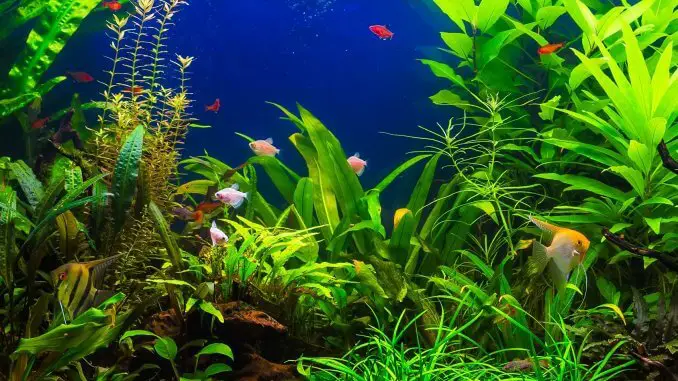
Plants help your aquarium in a variety of ways, such as: providing shelter for fish and keeping the water clean and oxygenated.
Picking the right plant prevents problems down the road.
Water wisteria is a species that will cause you very little hassle. It’s undemanding and hardy, so it can tolerate a variety of conditions. It only needs small amounts of maintenance so it doesn’t take up much of your time.
You can find it in most aquarium shops and you don’t have to buy many stems because it’s such an easy plant to propagate.
In addition, it provides your tank with bright green colors and can be grown as a carpet if you want it to be.
TABLE OF CONTENTS
Water Wisteria Facts & Overview
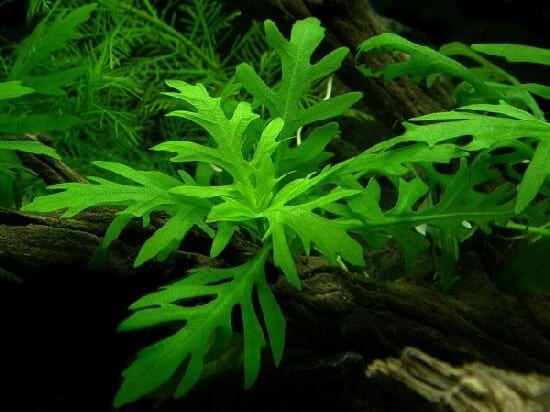
| Category | Rating |
| Family: | Acanthaceae |
| Care Level: | Easy |
| Growth Rate: | Fast |
| Maximum Size: | 20 inches |
| Minimum Tank Size: | 10 gallons |
| Water Conditions: | 70-82°F, pH 6.5-7.5, KH 2-8 |
| Lighting: | Moderate to high |
| Propagation: | Side Shoots/cutting |
| Placement: | Background or carpet |
Water wisteria (Hydrophila difformis) is a freshwater plant from the Acanthaceae family. It’s native to the Indian subcontinent, covering Bangladesh, Bhutan, India and Nepal.
Just like other plants, water wisteria provides lots of different services for your tank. This includes being a shelter or nursery for fish and keeping the water cleaner.
As one of the hardier aquarium species, this plant is popular for both beginners and experts because of its ability to handle common fishkeeping mistakes.
It’s easy to propagate too which helps people to multiply their populations from a relatively small supply.
These plants have attractive green leaves which brighten up any tank, just watch out for fish that get carried away when nibbling on them for food.
Uses for Water Wisteria (Carpet, Floating, and More)
There are lots of different types of aquatic plants and they all have different uses. The classic image of a plant is one that’s rooted into the sediment with the stem growing upwards towards the surface, but this isn’t always the case.
Water wisteria can either be rooted in the sediment or spread across the substrate surface like a carpet.
The biggest difference between these is visual. Carpets form a thick green layer that brightens the bottom of the tank. If the stems are growing upwards they add colors and shapes to the middle levels of the water which tends to be emptier.
Another difference is the shelter that they offer. Since carpets are so low down they’re mostly home to bottom-dwelling fish like loaches, whereas plants that are higher up can be shelter for mid-level fish.
Where you plant your water wisteria will depend on what you want to use it for.
Appearance
Stems of water wisteria can reach a height of up to 20 inches, and a width of around 10 inches. This means it covers a lot of the tank and might block out too much light if left uncontrolled.
The leaves are bright green, forming narrow protrusions along their length. They can take a few different forms, making them useful for scientists to study heterophylly (this is where leaves change their shape in response to environmental conditions).
The stem is slightly darker. It’s firm which helps to support the weight of the relatively large leaves.
Their thin white roots are buried beneath the substrate to anchor the plant in place.
Depending on how you plant it, this species can climb up to the surface of the water or spread across the bottom like a carpet (like Staurogyne repens).
Buying Water Wisteria
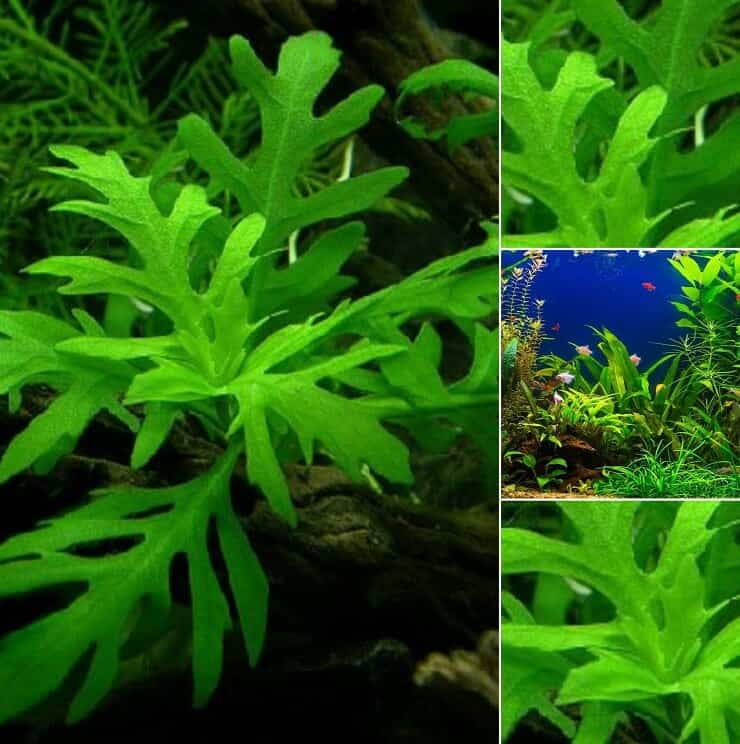
It’s important to find some strong specimens to buy, as they will have the best chance of survival.
There are a few things to look out for before you buy water wisteria. First of all, the roots should be long and abundant otherwise, the plant won’t be able to hold itself up or gather many nutrients.
The plant should be standing upright and able to support its own weight. Drooping specimens at the bottom of the tank should be avoided.
Make sure the colors are bright and consistent. If there are areas of yellow or brown, then it’s usually an indicator of a plant in poor health.
It is not hard to find this species, it’s stocked in most aquarium stores because it’s so popular. They range in price depending on the amount and size of the plants you buy. Expect to pay $5-10 for a good bunch. You don’t need to buy too much as you can propagate it over time at home (more on this later).
How to Care for Water Wisteria
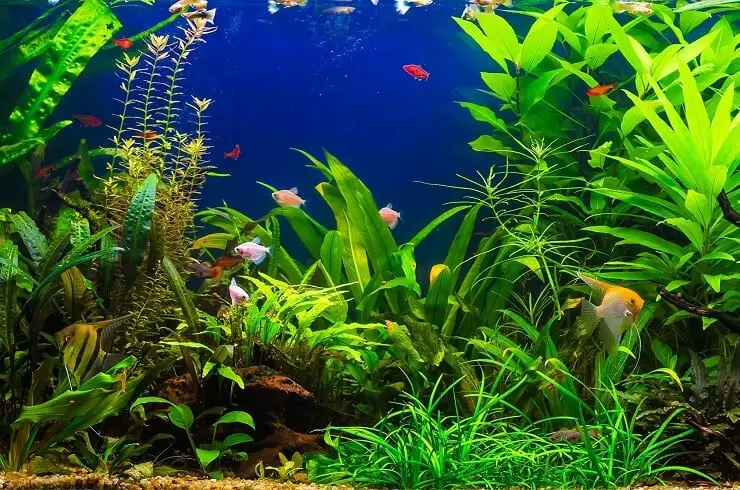
Tank Conditions and Requirements
These days water wisteria can be found all around the world, but in its native waters around India, this plant thrives in warm shallow waters where it has lots of access to sunlight.
The roots bury themselves in the sandy substrates of these waters, which might be either slightly acidic or slightly alkaline.
Fortunately, these wild conditions are easy to recreate at home. Water wisteria is an undemanding species so can tolerate a range of different setups.
Firstly, you need the right size tank. This species can be kept in setups as small as 10 gallons.
Ideally, stems should be planted in a sandy substrate to mimic their natural conditions, but fine gravels are suitable too.
You’ll need to heat the water to between 70-82°F. Temperatures outside of this range will slow the rate of photosynthesis, potentially stopping plant growth. Avoid extremes in pH. This species prefers neutral water values of 6.5-7.5. They prefer soft to moderately hard water as well (2-8 KH).
The rest of the tank is free for you to design. The only other thing that water wisteria will need is access to light, but most aquarium lights are fine for photosynthesis as long as you make sure the plants aren’t in shaded areas.
How to Plant
You need to think about how you’ve set up your tank when planting. It’s important to use the right substrate or they won’t be able to grow properly. In the wild they’re rooted in sandy substrates, so this is the ideal option for your tank.
Fine gravels are suitable too but avoid any larger grained substrates. The roots need to be able to easily move through the grains to firmly hold the pant in place and gather nutrients.
Plant your stems in areas where they have plenty of access to light for photosynthesis, otherwise, they won’t be able to grow.
Make sure that your plants aren’t kept too densely, or they will compete with each other. Start with just a few, spaced a couple of inches apart. You can propagate some stems later if you have extra space.
If you want the carpet effect, plant your stems on their side and root them in place. Only the leaves facing upwards will grow to create a carpet effect. If you don’t want the carpet effect, you just have to plant the roots in the substrate and leave the stems to grow towards the light like they normally would.
Care and Maintenance
Water wisteria is one of the faster-growing species of plant, so perhaps the biggest issue you’ll have is keeping its size down.
You can easily control this by trimming the stems back down to the size you want. If you let it grow too large it will start to crowd your other plants or block out light to the areas below.
When trimming, make sure to remove your cuttings from the tank or they will fall to the substrate and gradually grow into their own plant.
Since they grow so fast they use up more nutrients than other species, sometimes causing a nutrient deficiency. You could try adding some nutrient supplements if you don’t think your plants are growing as well as they should. Watch that you’re not promoting excessive algae growth though.
Water Wisteria Propagation
The process of propagation is quite simple both in captivity and the wild.
Naturally, water wisteria would grow to a point where parts of the plant begin to fall off. These would then develop into new plants.
The process occurs in the same way in an aquarium, but you’re able to manipulate it a bit. You can take cuttings and plant them where you like. This species grows fast so would quickly fill a paludarium.
Once you have a mature plant reaching full height, you can cut the top 5 inches or so from the stem. Plant these somewhere else in the substrate and they’ll start to grow roots and develop into their own plant.
Make sure the cutting you make has leaves so it can photosynthesize.
Compatibility and Tank Mates
You can keep it with other plant species, just be careful the tank isn’t too densely planted. Consider the areas that your plants will grow into, making sure there’s little overlap. You don’t want them competing or some may die off.
Most fish can be introduced without any problems, but there are a few that should be kept separate. The leaves of water wisteria are ideal for nipping and some fish will take advantage of this.
Research fish before you add them to check if they eat plants. Goldfish, rainbow fish, and silver dollars are just a few examples that might destroy your plants.
Water wisteria is a hardy plant that can survive some nibbling but only to a certain extent. Most cichlids are usually fine, except a few that might uproot the stems (like Oscars). Other ideal tank mates include bettas, cherry barbs, Corydoras Catfish, Danios, Dwarf Gourami, Guppies, Mollies, Rasboras, Swordtails, and tetras.
Most, but not all, species of snail will tear through your plants when they get hungry. If your heart is set on adding snails then assassin snails are less likely to eat plants.
Shrimp are another option and shouldn’t impact on your plants too much.
Is Water Wisteria Suitable for your Aquarium? (Summary)
There aren’t many tanks that this species can’t be added to. Water wisteria is a hardy species, so it can be added to lots of different setups.
Check that your water conditions are suitable and make sure that you don’t have any problematic fish that are likely to destroy the plant. These are the most common causes for the death of this plant.
The popularity of this species makes it cheap to buy. It’s one of the most accessible hardy aquarium plants in the fishkeeping industry.
Their fast growth rate means you can propagate stems quickly.
It will prove that it was value for money by helping to keep the tank clean, solving problems before they arise.
Is water wisteria one of your favorite aquarium plants? Have you tried using it as a carpet species? Let us know your experiences in the comments section below…

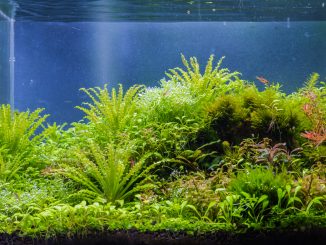
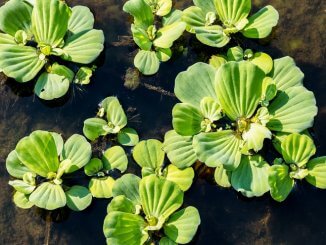
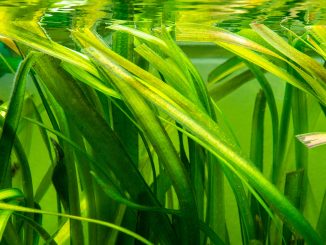
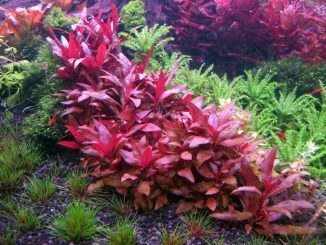
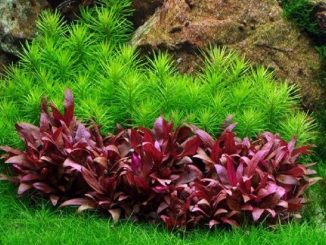
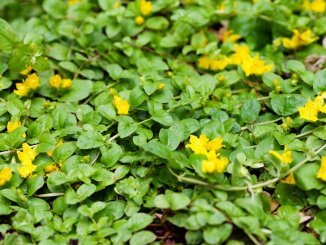
First, thank you for your in-depth coverage of many important aspects of aquarium life. I’m in the process of setting up a 100 gallon salt water reef tank. I read that the wisteria plant can be added to fresh water aquariums. I would like to know what you recommend for salt water plants that are easy to work with. Thanks in advance!
Thanks Rich. We’ll be covering many aspects of saltwater tanks in depth in this coming year. Please feel free to keep checking back, or to sign up to our emails so you will get a notification each time a new article is added. Thanks, Robert
Hi, I had success planting wisteria previously. However for my current tank, all my wisteria plants have many yellowish worn leaves except the top layer. I don’t know why.
Hi Sue, here are a few suggestions; check the water parameters including ammonia, nitrites, nitrates and pH. Do you have a suitable substrate, not overloading with light, using fertilisers? Thanks, Robert
Will wisteria work in a brackish water tank?
I am wondering if this plant is able to grow out of the water. I have a very large vase I am trying to set up for a beta and am wanting a plant for inside as well as moss…but also want a plant to plant at the opening of the vase and the roots will sort of dangle into the tank. Any recommendations for that type of plant? Thank you.
You can try pothos,but if your Betta likes nibbling on roots it might not be a good idea as pothos have some toxicity in their roots. Try semi aquatic plants, or make it an hydroponic vase by using potatoes and other such plants like strawberry.